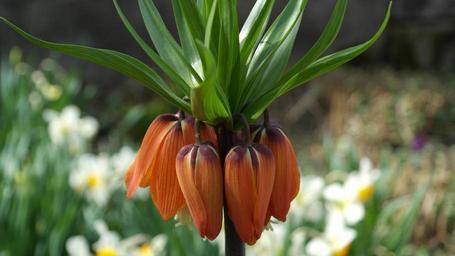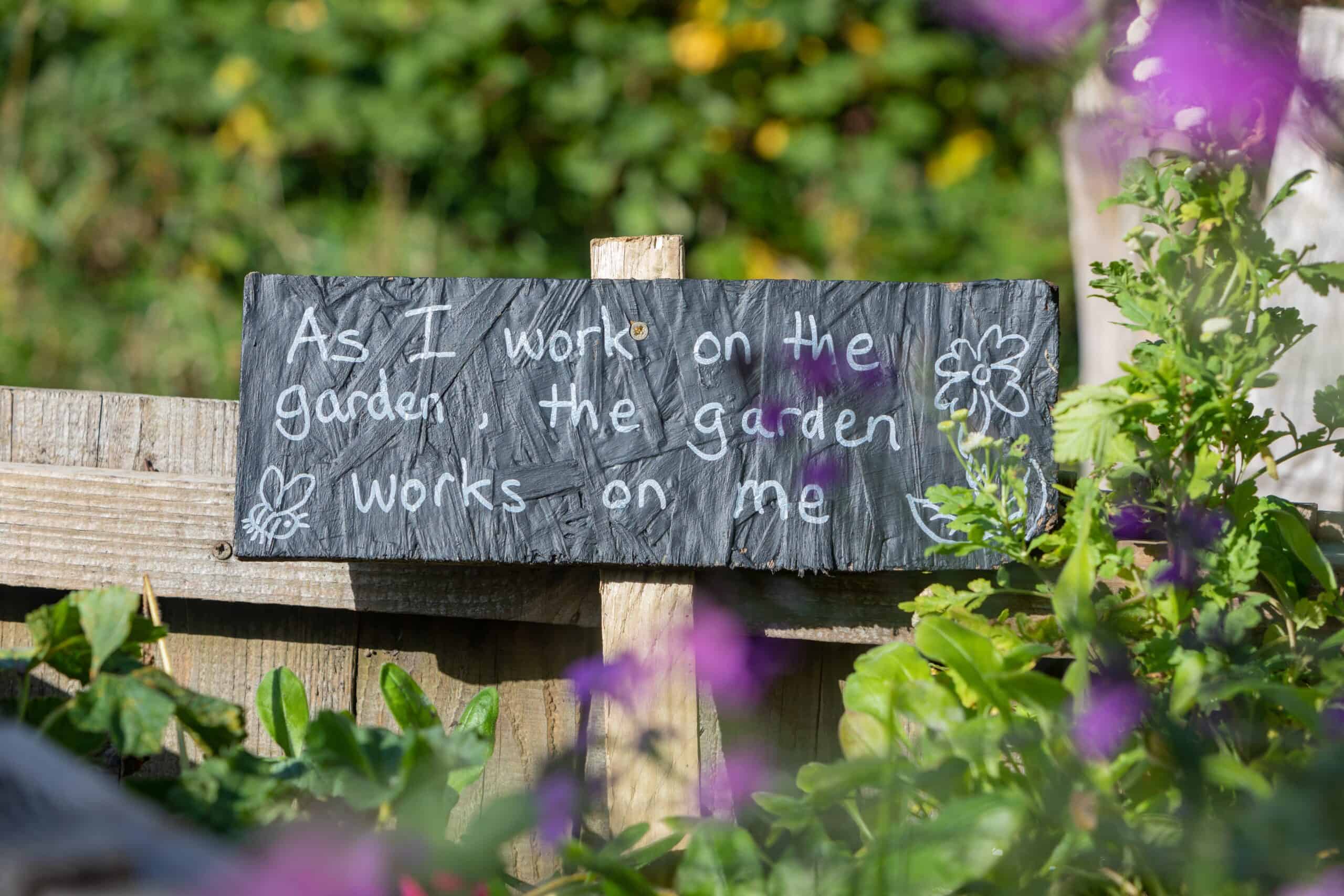The Fritillaria imperialis, commonly known as Crown Imperial, is a showy bulbous herbaceous perennial belonging to the Liliacea family. Crown Imperial produces a display of orange pendant, bell-shaped flowers, topped by a crown of tiny leaves that look a little like the top of a pineapple. This plant is a perennial and grows up to 44 inches tall. It blooms in mid to late spring for three to four weeks. The flowers are very popular due to their showy display, musk-like odor, and they are ideal for back borders.
How to Plant
Crown Imperial is best planted in mid to late winter, preferably before the beginning of spring. Plant the bulbs in a hole that is twice the size of the bulb and a minimum of 5 inches deep. Add some organic or slow-release fertilizer in the soil when planting to ensure good growth. The bulbs require full sun or partial shade in well-drained soil. Keep the soil moist at all times and water regularly. To prevent crown rot, do not allow the soil to become soggy or water soaked. Also, for the plant to be fully healthy, the soil temperature should not be colder than 18°C.
Meaning and Symbolism
Crown Imperial has its origin from the Greek word “Fritillus” which means dice box and was attributed because of the checkerboard pattern on the flower petals. Another belief of the flower’s etymology is that it was derived from the Latin word “imperialis” referring to the plant’s regal and stately ornamentation. Due to its name, the crown imperial is associated with monarchs, nobility, and grandeur, and can be the perfect gift for people celebrating such moments. Also, since its bloom period falls around springtime, it symbolizes springtime freshness, renewal, and joy.
History, Mythology, and Religious Significance
Crown Imperial has been around for a very long time. In the Victorian era, this plant was a popular flower among gardeners and flower enthusiasts. It was said to be a common sight in the royal gardens during this period. This flower was also a popular flower throughout the Middle Ages as well. The flower was accessible as there were a great number of Imperial Crowns that could be found in fields, woodlands, and wilderness areas.
In terms of mythology, in Greek mythology it was believed that this flower was used by Demeter to provide warmth to Proserpine when she had to return to the underworld. Also, in Native American mythology, the roots of this flower were highly sought after due to its medicinal properties.
In religious terms, the Crown Imperial is a source of inspiration for Christians due to its association with the crown of thorns placed on Jesus’ head during the crucifixion.
Flower varieties and their defining characteristics
Fritillaria imperialis comes in a number of varieties. The most common one is the Crown Imperial. This variety of the flower grows up to 44 inches tall, and the clumps of its foliage are topped by the bright orange bell-shaped flowers. The other popular varieties include ‘Maxima Lutea’ which has large yellow flowers and grows up to 20 inches tall. The White Heirloom variety is one of the most distinctive varieties of Fritillaria imperialis which has white flowers and grows up to 24 inches tall. The ‘Black Pearl’ variety has deep purple flowers and a clove-like scent and grows up to 32 inches tall. Finally, the ‘Argenteovariegata’ variety features a distinctive yellow and white variegated foliage and grows up to 16 inches tall.
How to Pot and Repot
The Crown Imperial should be kept in pots or containers over the winter, so that its roots won’t freeze. These plants don’t require overly large containers, and a container with a diameter of 6 to 8 inches should suffice. Place the bulbs in the pot and cover them with soil ensuring sufficient coverage. Cover the pot with plastic and keep it in a cool and dry place such as a garage or basement.
When you need to repot the Crown Imperial, use a pot with a drainage hole and preferably of a terra cotta type material. Make sure to use a soil that is well drained, but still rich in organic matter. All the repotting should be done when the leaves of the plant are still dormant. Before repotting, water the container generously but make sure to empty the container after an hour so that the soil is moist and not wet. Take the bulbs out of the pot and place them in the new container and cover them with soil making sure you do not bury the corms too deeply.
How to Prune
The foliage of Fritillaria imperialis plants need to be removed once the blooming period has passed. This can be done by cutting it off at soil level. This should be done when all the leaves have gone yellow. The bulbs should be kept in their pots over the summer season in order to maximize the edge of water and nutrition to the bulbs so that they can prepare for the next growing season.
How to Propagate
The easiest way to propagate Crown Imperial is by division. Once the flowering period has passed, the bulbs can be divided by gently separating the corms. Make sure to plant the divisions in separate pots and place them in a cool, dark and dry place until autumn.
Common Pests and Diseases
Crown Imperials are prone to several pests and diseases. The most common are Fusarium and other rot, which is caused by fungus attacking the roots and corms of the plant. This can be controlled by paying attention to the soil moisture level and maintaining good air circulation. Some other common pests that can attack the Crown Imperial include aphids, slugs, and caterpillars. These pests can be controlled by the use of specific insecticides.
Three Frequently Asked Questions about Fritillaria Imperialis
Q. How do I protect the bulbs over the winter?
A. The bulbs should be kept in pots or containers over the winter so that their roots won’t freeze. Place the container in a cool and dry place such as a garage or basement and cover it with plastic.
Q. How often should I water the plant?
A. It is important to keep the soil moist at all times but make sure not to overwater the plant. This will help to prevent root rot.
Q. When is the best time to repot?
A. The best time to repot is when the leaves are still dormant, preferably before the beginning of spring.
Fact Sheet
| Crown Imperial | Fritillaria Imperialis |
|---|---|
| Family | Liliacea |
| Plant Type | Perennial |
| Mature Size | Up to 44 inches |
| Sun Exposure | Full Sun or Partial Shade |
| Soil Type | Well-drained |
| Soil pH | 6.3 to 7.3 |
| Bloom Time | Mid to late Spring |
| Flower Color | Orange or Yellow |
| Hardiness Zones | 4-8 |
| Native Area | Europe, Northwest Africa and the Caucasus |
| Uses | Back Borders, Cut Flowers, Landscaping |
How to Compost Crown Imperials
Composting is a great way to recycle organic material and nourish Fritillaria imperialis plants. When composting Crown Imperials, you need to first prepare the compost. To do this, mix together equal parts brown (carbon material) and green (nitrogen material) material. Examples of brown material include fallen leaves, straw, and wood chips while green material can be grass clippings and kitchen waste. After the materials have been mixed, add some water and allow the mixture to become damp but not soggy.
After the compost prepared, dig a hole at least 6-inches deep in the soil and mix in some compost. Place the bulbs in the hole, cover it with some compost from the mixing process and water the bulbs. The compost should be kept moist as the bulbs are developing roots, so you may need to water it a few times. Once the flowers have been established in the compost, you can add a layer of mulch to retain moisture in the soil during the growing season.
Common Companion Plants for Fritillaria Imperialis
The Fritillaria imperialis looks great when planted with a number of other companion plants. These include but are not limited to:
– Tulips
– Narcissus
– Allium
– Oriental poppies
– Foxgloves
– Primrose
– Astrantia
– Hellebores
– Fennel
Making Arrangements with Fritillaria Imperialis
The Fritillaria imperialis are often used in flower arrangements as they bring an eclectic look to the design. The bright orange flowers can be used to create a beautiful and unique centerpiece or bouquet. Generally, the Crown Imperial should be placed at the back of an arrangement as its tall flower stems will add height to any design. When arranging the Crown Imperial, cut the stems about an inch shorter than the desired height and make sure to keep the arrangement away from direct sunlight.
Tips and Tricks for Maintaining the Fritillaria Imperialis
Maintaining the Fritillaria imperialis requires some effort but the reward is a beautiful plant that will last for many years. These are some tips that you should consider when caring for your plants:
– Make sure to water the plants regularly as they do not tolerate drought.
– The soil should be well-drained as the plants are prone to root rot.
– Do not over-fertilize the plants as this can cause root burn.
– Plant the bulbs deep in the soil in order to protect them from animals such as squirrels.
– Snip the foliage off, at soil level, once the flowering period has ended.
– Do not allow the soil to become too dry in summer as this will dry out the bulbs.
– Choose a location for the plant that is sheltered from strong winds and direct sunlight.
What we love from Amazon this week
Buy these wonderful flowers directly from Amazon:















